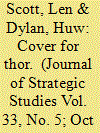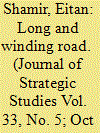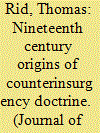| Srl | Item |
| 1 |
ID:
099707


|
|
|
|
|
| Publication |
2010.
|
| Summary/Abstract |
In the late 1950s, as intercontinental ballistic missiles (ICBMs) replaced bombers, the development of Soviet ICBMs prompted fears of strategic vulnerability in the West. The Eisenhower administration's decision to deploy Intermediate Range Ballistic Missiles (IRBMs) on the territory of NATO allies sought to redress the perceived vulnerability until American ICBMs were ready. British deception planners considered how to enhance the threat posed by the IRBMs. An outline plan codenamed 'Celestial' was intended to persuade the Soviets that the otherwise vulnerable missiles could not be readily neutralised. This article explores this deception and how such planning also sought to convey accurate information alongside disinformation. It also suggests that deception planners appear to have given little heed to the potentially counterproductive consequences of such an operation.
|
|
|
|
|
|
|
|
|
|
|
|
|
|
|
|
| 2 |
ID:
099705


|
|
|
|
|
| Publication |
2010.
|
| Summary/Abstract |
This article comprises a reply to those who seek to use the British historical experience in Afghanistan in order to draw parallels with current operations in that country. It argues that, while the conceptual and physical response to the issue of Afghanistan on the part of Empire policy-makers during the period 1839-1919 was characterised by periods of indecision and mistaken assumptions, their grasp of strategic principles allowed the formulation of a series of Afghan policies that would serve to protect and indeed enhance British interests in the region for over a century and which stand in stark contrast to the seemingly incoherent Afghan strategy articulated by the current British government.
|
|
|
|
|
|
|
|
|
|
|
|
|
|
|
|
| 3 |
ID:
099703


|
|
|
|
|
| Publication |
2010.
|
| Summary/Abstract |
The purpose of the current paper is to examine the adoption and adaptation process of mission command (Auftragstaktik) in the US Army. This concept, developed by the Prussians, denotes a decentralized command approach wherein superiors dictate their intent and allow subordinates to formulate their operational plans independently and change it according to the emerging situation. The paper examines the US command approach prior to the adoption of mission command. It argues that it was heavily influenced by corporate management practices which inherently contradict mission command approach. It continues and investigates how the US Army endeavored to emulate the approach in its doctrine and in major operations.
|
|
|
|
|
|
|
|
|
|
|
|
|
|
|
|
| 4 |
ID:
099704


|
|
|
|
|
| Publication |
2010.
|
| Summary/Abstract |
The North Atlantic Treaty Organization (NATO) has since the turn of the new century experienced a double transformation gap: between global and regionally oriented allies and between allies emulating new military practices defined by the United States and allies resisting radical change. This article takes stock of these gaps in light of a decade's worth of collective and national adjustments and in light of counter-insurgency lessons provided by Afghanistan. It argues first of all that the latter transatlantic gap is receding in importance because the United States has adjusted its transformation approach and because some European allies have significantly invested in technological, doctrinal, and organizational reform. The other transformation gap is deepening, however, pitching battle-hardened and expeditionary allies against allies focused on regional tasks of stabilization and deterrence. There is a definite potential for broad transformation, our survey of officers' opinion shows, but NATO's official approach to transformation, being broad and vague, provides neither political nor military guidance. If NATO is to move forward and bridge the gap, it must clarify the lessons of Afghanistan and embed them in its new Strategic Concept.
|
|
|
|
|
|
|
|
|
|
|
|
|
|
|
|
| 5 |
ID:
099706


|
|
|
|
|
| Publication |
2010.
|
| Summary/Abstract |
In counterinsurgency, the population is the center of gravity. This insight has become a key doctrinal tenet of modern armed conflict. But where does it come from? The razzia, a tactic introduced by the French in North Africa around 1840, first thrust tribal populations into the focus of modern operational thinking. Soon the pioneering bureaux arabes added an administrative, civil, and political element. Eventually, in the 1890s, French operations in Madagascar gave rise to a mature counterinsurgency doctrine. David Galula, a French writer who heavily influenced the American Counterinsurgency manual, is merely the joint that connects the nineteenth century to the twenty-first.
|
|
|
|
|
|
|
|
|
|
|
|
|
|
|
|